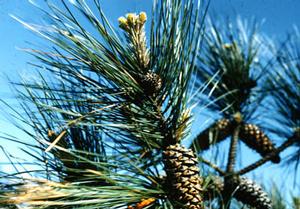Pines and relatives
Carissa Klatka & Irina Kim
University of Georgia, Athens
|
|

Loblolly Pine
Pinus taeda
Photo courtesy of the UGA Herbarium
|
- Abies
- Biota
- Callitris
- Calocedrus
- Chamaecyparis
- Cupressus
- Juniperus
- Larix
- Libocedrus
- Picea
|
- Pinus
- Platycladus
- Pseudotsuga
- Sabina
- Sequoia
- Sequoiadendron
- Strobus
- Taxodium
- Thuja
- Tsuga
|
Identification
Trees in the genus Pinus have been described:
"The Pines have needle-shaped leaves which are arranged in bundle-like clusters of from 2 to 5. Each cluster is surrounded at the base by a persistent or deciduous sheath, and borne in the axil of a small, deciduous scale-like primary leaf. The needle-like leaves persist on the branches fro two, three, or more leaves. The flowers appear on the branches when growth is resumed in the spring. Clusters of staminate flowers occur near the base of the new growth; the pistillate flowers being scattered singly or in small clusters along the new shoots. Pollen is produced so abundantly that "showers of sulphur" seem to occur in pine stands at blossom time. It is carried by the wind to the receptive stigmas of the pistillate flowers. After fertilization the pistillate flowers develop into woody-scaled cones. It usually takes two, and sometimes three years for the cones to reach maturity. The seeds are winged and are dispersed by the wind" (Grimm, 1983).
Trees in the genus Picea have been described as "evergreen trees of pyramidal habit. Leaves are arranged singly on branchlets, each one being attached to a short, woody stalk which persists on the twig after the leaf falls"(Grimm, 1983). Ovoid cones mature during the first season and usually fall during the first or second winter (Grimm, 1983).
The genus Tsuga are "evergreen trees with a more or less pyramidal habit and with slender horizontal or drooping branches. The linear and flattened leaves are attached to the branchlets by little woody stalks which sersist after the leaves fall" (Grimm, 1983). Staminate and pistillate appear on the tree in the spring; cones usually mature after one season and remain over winter (Grimm, 1983).
Members of the genus Abies have stalkless linear needles that leave circular scars on the branchlets when they are shed over the years. Flowers appearing in the spring are usually not noticed. Cones mature the first year; but instead of falling off whole, just the scales and "attendant bracts" fall off (Grimm, 1983).
The genus Larix slightly different from the other members in this family. It sheds all of its leaves in the winter, leaving smooth orange-brown twigs exposed. Cones mature in the first fall and stay on through the winter. Leaves are arranded in clusters on "short, lateral, spur-like branches" (Grimm, 1983).
There is a good identification key of the species in each genus in The Illustrated Book of Treees by William Carey Grimm.
Common names & synonyms
Photographs
- Calphotos: Plants -- a large collection of plant images, primarily Californian species
Phylogeny
|
Taxonomic Category |
Scientific Name |
Common Name |
| Division |
Gymnospermae |
Gymnosperms |
| Order |
Pinales |
Conifers |
| Family |
Pinaceae |
Pine family |
|
Links to other sites
References
- Collingwood, G.H. and W.D. Brush. 1978. Knowing Your Trees. The American Forestry Association. Washington, D.C.
- Coombes, A.J. 1992. Trees. Dorling Kindersley, INC. New York, NY.
- Duncan, W.H. and M.B. Duncan. 1988. Trees of the Southeastern United States. The University of Georgia Press. Athens, GA.
- Grimm, W.C. 1983. The Illustrated Book of Trees. Stackpole Books. Harrisburg, PA.
- Mirov, N.T. and J. Hasbrouck. 1976. The Story of Pines. Indiana University Press.
- Jacques. H.E. 1949. Plant Families: How to Know Them. WM.C. Brown Company Publishers. Dubuque, Iowa.
- Pielou, E.C. 1988. The World of Northern Evergreens. Cornell University Press. Ithaca, NY.
- Vidakovic, M. 1991. Conifers. Grafickizavod Hrvatske. Croatia
Acknowledgements
|
